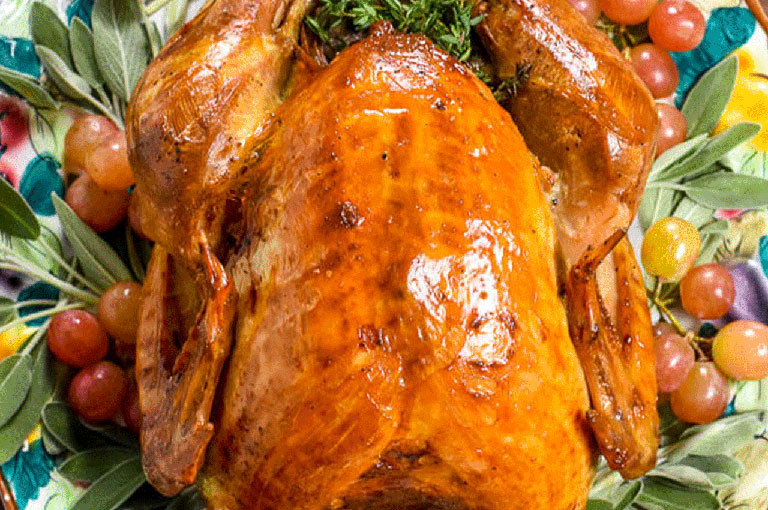
How to brine turkey
Cooking a whole turkey, especially a large one, takes 2½ to 5 hours. The lean parts of the bird, such as the breasts, often cook within the first hour and end up overcooked before the rest of the bird is ready. Fortunately, there’s a simple way to solve this problem, and that’s brining your turkey before cooking. Brining locks water and salt inside a turkey so that the meat stays moist and tender after it leaves the oven. It also infuses the turkey with loads of flavor, leaving you with juicy, tasty meat.
Please be aware that many of our turkey products come brined or ‘basted’. Check the label to see if your turkey has been brined. If so, we don’t recommend further brining as it may cause your turkey to taste overly salty.
You can wet or dry brine your bird, but before discussing how to brine turkey, let’s look at more reasons why everyone should brine before cooking.
Wet Brining vs. Dry Brining
The correct answer to how to brine turkey depends on the type of results you want. For the juiciest and moistest turkey, wet brining is your best option. Wet brining involves soaking your turkey in a bath of saltwater and refrigerating it for 24 to 48 hours.
Wet brining will increase the turkey’s moisture. That extra moisture helps ensure that the meat doesn’t go dry during cooking. The salt in the brine will also flavor and tenderize the meat so that it takes less time to cook.
For the tastiest turkey with crispy skin, go with dry brining. Dry brining, also called salting, involves coating all parts of your turkey with salt & seasonings and letting it rest in the fridge for 12 to 24 hours.
The salt will extract the turkey’s existing moisture and flavor it. The turkey will then reabsorb this moisture, which will break down muscle proteins and prevent them from releasing moisture during cooking. The end result is a moist, tender, and highly flavorful turkey.
Below are some other differences to consider before choosing wet or dry brining:
- Space: Wet brining takes up a lot of fridge space for one to two days, making it unideal if your fridge isn’t large enough to hold a tub of brine and turkey.
- Time: Compared to wet brining, dry brining takes less time to deliver impressive results. However, a dry brined turkey will not be as moist as a wet brined turkey.
- Cooking Mess: Wet brined turkey releases a lot of moisture during cooking, which can leave a mess in your grill or oven.
Please be reminded that you should not brine pre-salted, enhanced, or self-basting turkeys. Since such turkeys already contain seasonings, brining could lead to too salty meat.
Why Brine Your Turkey?
Below are some of the top reasons why you should never skip brining before cooking your turkey:
Faster Cook
Brined turkey takes less time to cook. The salt in the brine breaks down a lot of the protein, causing the dark meat to become tender in less time.
Juicier
Brining forces turkey to absorb extra moisture. A lot of that moisture stays inside the turkey during cooking, leaving you with juicy white and dark meat when the cooking is over.
More Flavor
Applying topical seasoning to a whole turkey only goes skin deep, leaving you with a tasty surface and bland interior. Brining allows salt and other brine seasonings to seep deep into your meat, giving you a tastier bird.
Even Cook
If cooking a whole turkey, the white meat can overcook before the dark meat can reach an internal temperature of 165 degrees Fahrenheit. Brining helps prevent this by keeping the white meat moist until the dark meat cooks completely.
How to Wet Brine a Turkey
If you prefer the results of wet brining over dry brining, here’s how to brine a turkey in saltwater:
What You’ll Need
- Kosher salt
- Water
- A large, food-safe container
- Other spices or aromatics (optional)
Instructions
- Create your saltwater solution by mixing four tablespoons of kosher salt with one quart of warm water. That means if you need four quarts of water to submerge your turkey fully, you will need 12 tablespoons of salt.
- Add aromatics, such as bay leaves, rosemary, or ginger, to boost the brine’s flavor.
- After the brine cools to at least room temperature, pour it over the turkey inside your food-safe container. If the turkey floats, weigh it down with a plate. You can begin the wet brining process while your turkey is still frozen, or begin with a thawed turkey.
- Cover the container and store it in your fridge for 24 to 48 hours. Your fridge’s temperature must not be over 40°F. A higher temperature will lead to harmful bacteria growing in your turkey and contaminating your fridge.
- After brining, take the turkey out of the water, throw away the brine, and pat the turkey dry with a paper towel. Rub your preferred seasoning on the turkey’s body and cavity before cooking.
How to Dry Brine a Turkey
If you prefer dry brining, here’s how to do it:
What You’ll Need
- Kosher salt
- Dried herbs (such as thyme, sage, and rosemary)
- Black pepper
- A large rimmed baking sheet or roasting pan
Instructions
- Create your dry brine rub. For a 14 to 16-pound whole turkey, you will need three tablespoons of kosher salt. Combine the salt with half a teaspoon of thyme, paprika, black pepper, oregano, and rosemary.
- Completely thaw the turkey and pat the surface dry with paper towels. Apply your brine rub all over the turkey’s body and inside its cavity.
- Place the seasoned turkey on a rack inside a rimmed baking sheet and put it in the fridge uncovered for 12 to 24 hours.
- After brining, take the turkey out of the fridge, brush off any excess salt, and let the turkey come to room temperature. Once the bird reaches room temperature, cook it any way you desire.
Bonus Tip:
For extra moist dry brined turkey, rub some butter between the turkey skin and meat before brining the bird. During cooking, the butter will melt and baste the turkey to make it juicier and more flavorful.
Cooking a Brined Turkey
Now that you know how to brine turkey, all that’s left is the cooking. Whether you wet or dry brine your turkey, you can cook it any way you prefer, including:
Note that while frying a wet brined turkey is possible, the meat’s high moisture content may lead to a lot of splashing oil. Also, since brined turkey cooks quicker than regular turkey, start checking the bird’s internal temperature at least an hour before your regular estimated cooking time.
Lastly, before carving your cooked turkey, let it rest for at least 20 minutes. If you carve the turkey without letting it rest, its tasty juices will seep out, leaving you with dry meat.
Ready for Brined Turkey Recipes?
Now that you have the brining process down, check out these recipes to make your next turkey-based meal.
Wet Brine Turkey Recipes
Dry Brine Turkey Recipes
Turkey Brining FAQs
You should wet brine a whole turkey for at least 24 hours but not more than 48 hours. If you add vinegar or citrus juices to your wet brine, do not brine for more than 24 hours, or the meat may become spongy. Dry brining takes 12 to 24 hours.
Do not rinse a turkey after brining. Rinsing a brined turkey will wash away most of the salt that should flavor the meat. Instead of rinsing, use paper towels to pat your brined turkey dry before cooking.
Brined turkeys cook slightly faster than unbrined turkeys. However, due to the extra moisture in a wet brined turkey, your meat won’t dry out if you overcook it for a few extra minutes.
Hungry for More?
Sign up to get exclusive recipes, cooking tips, and seasonal inspiration directly to your inbox.
Join Now-
Products
It is our mission to provide you the highest quality turkey products to create and share wholesome meals with the ones you love.
Learn More -
Recipes
Thanks to turkey’s lean protein, you know you’re eating a meal you can feel good about. Dig in to find a new favorite for you and your family.
Learn More
